I was looking at trndbot and it's buy/sell signals are pretty good - what algorithm are they using to generate these signals? Although it maybe similar to bollinger bands, it algorithmically generates these live signals for any trading graph:
-
1$\begingroup$ Hmmm... it looks a little too good to be true, don't you agree? How do we know they are not using lookahead in their algorithm. The only way to test a proprietary algorithm is with live data, where no one knows what will happen next. $\endgroup$– nbbo2Mar 14, 2021 at 0:35
-
$\begingroup$ @noob2 I agree, they have a live feed callback API, that appears to be working... Although it could still be delayed. $\endgroup$– rookMar 15, 2021 at 20:25
2 Answers
Although it’s their own marketing and should be taken with a grain of salt they claim:
Buy and Sell Signals.
Our proprietary algorithm bot uses complex logic and mathematical equations to predict profitable trades, and to notify you when its time to sell.
Either it will be hard to reverse engineer because of the complexity of their method, or the properties of the algorithm are overstated and it’s not really worth your time to reverse it. It might for example be more simple or have look ahead bias.
-
$\begingroup$ Probably correct, but what are the best algorithms that we have to produce signals like this? $\endgroup$– rookMar 15, 2021 at 20:25
-
$\begingroup$ Suppose a general method exists and it’s known. People will use the method to trade. To make use of the opportunity they need to take advantage before anyone else does. This changes the dynamics and reduces the opportunity. So the method stops working. $\endgroup$– Bob Jansen ♦Mar 15, 2021 at 20:32
I don't know how this TradingView script works, but I wouldn't be surprised if it was implemented as follows. It calculates where to place buy/sell signals to maximize the hypothetical trading profit for the historical data on the chart. The number of signals is controlled with 'Sensitivity' parameter. Higher sensitivity translates into more signals, hence more profit. Then the script applies the same parameters that worked for historical data to real-time updates. If the chart is reloaded with a different timespan, or different bars, the signals would be placed at different times, or even reverse.

